With Standard finished and Grand Prix Dallas
square in the rearview mirror, I’m going to speed forward into Legacy. Legacy has been a format in considerable flux over the past month, ever since
Alix Hatfield victory in the Edison Open with High Tide. If you’ve
followed SCGLive’s coverage through March then you already know that this story has a poetic ending, but I’m not one to jump the gun. I prefer to just
tease you with the gun via gentle prodding.
As I did with Standard last week, I’m going to offer a snapshot of each tournament’s metagame organized by popularity. I’ll then combine everything for
a metagame breakdown and matchup chart on Tier 1. Legacy happens to be far more diverse than Standard, especially right now, so this tends to wind up
excluding some contenders by very narrow margins. Just because your favorite deck isn’t popular doesn’t mean it’s not doing well, and just because it’s
doing well doesn’t mean it’s popular. Or something like that.
Given that there was some confusion on Twitter this week, I’ll explain the graphs once again. All win percentages listed below have had mirror matches
removed, although sub-archetypes can face off against one another. For example, Bant’s win percentage includes no pairings of any Bant deck against NO
Bant, while NO Bant’s win percentage includes pairings against Aggro Bant but not against other NO Bant lists—that’s why the draws of the
sub-archetypes occasionally exceed the total draws of the archetype.
In addition, any archetype that made up less than 1% of the field has been removed, and only archetypes that composed 5% or more are considered Tier 1,
which does not speak to the quality of a deck, only its popularity. Also remember that these win percentages are only indicators of how many matches a
deck won of the matches it played—nothing more than an indication of one weekend’s performance. Click here for the full spreadsheet!
Memphis Legacy Open
Metagame Breakdown
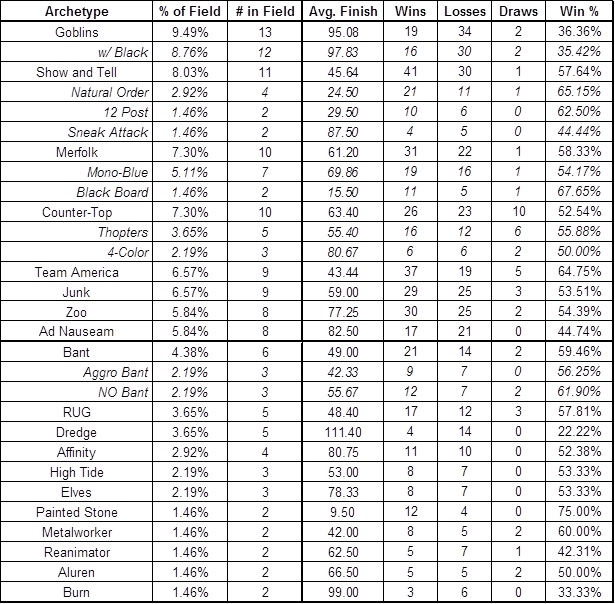
Oh, how the mighty have fallen. Goblins spent the start of the year smashing the Open Series to pieces, and now it’s time to pay the piper. While its
popularity has not waned, its results sure have as players adapted to beat Aether Vials and four-cost 2/2s that draw some cards. Show and Tell surged
after Edison in a popularity move I’ll chalk up to regionalism and the favor of certain grinders, and it performed rather well. Counter-Top remained a
good choice, but its popularity continued to dip as a result of the format diversifying. As the critical mana cost of the format has become three and
Green Sun’s Zenith has offered green decks an easy to resolve threat, things are getting weird for Counter-Top pilots right now.
Alex Bertoncini won the event with Merfolk while AJ Sacher put NO Bant on the map in a big way with his innovative list and finals finish. Both of these players have
ground out a ton of matches with their respective archetypes, and it was rewarding to watch their practice pay off. This finish vaulted AJ Sacher
straight to Level 5 in our Player’s Club, which he has continued to put to good use on our circuit. For Alex, it was a vindicating victory that gave
him the lead in the Player of the Year race (for one whole week) and Level 6 status, while also solidifying mono blue Merfolk as the color combination
of choice.
The real story of the Memphis metagame became Team America. The deck was so good, even Standard wunderkind Edgar Flores managed to post a Top 8 finish!
I kid, buddy—but Team America definitely stormed Memphis. That suited Alex Bertoncini just fine, given how well Merfolk match up against Tombstalkers.
Working quietly in the Top 16, Painted Stone continued to prove that Caleb Durward’s little darling was a very real threat. /foreshadowing!
Dallas/Fort Worth Legacy Open
Metagame Breakdown
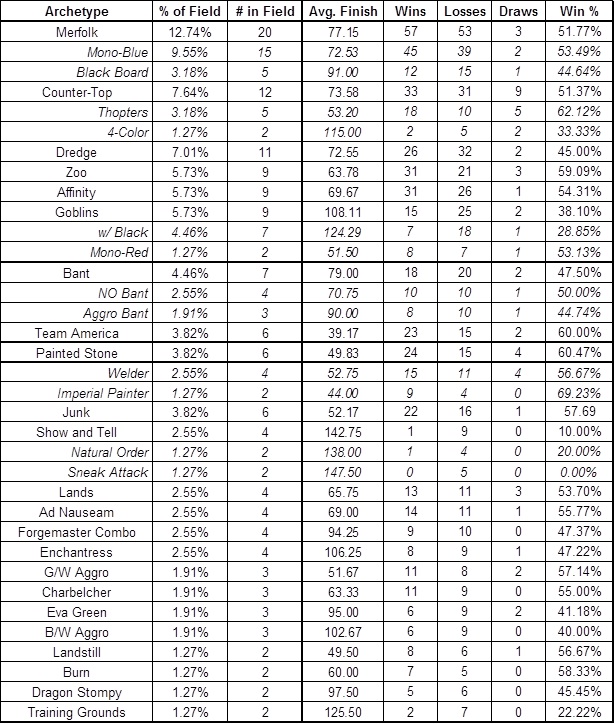
Alex Bertoncini triumph in Tennessee led to a boost for Merfolk on the following weekend, and Alex himself even cracked the Top 8 a second time.
Counter-Top’s numbers held, but a number of other decks dipped, resulting in a lot of different decks occupying relatively small slices of the
metagame. Bant, one of the strongest decks in the format, continued to haunt the second tier, while Team America dropped down there as well, presumably
a result of issues related to cost and interest. The deck performed very well, but Affinity wound up taking the tournament down in the hands of Blake
“Unleash the” McCracken. Gerry Thompson walked away from his semifinal match against Blake with a shrug, powerless against the mechanical menace. Many predicted that Affinity would make the
jump to Tier 1 after this victory. With a Top 4 in Memphis and a win here, one of the cheapest decks in Legacy appeared to finally be a fighter.
This week forecasted Los Angeles nicely, with an uptick in the popularity of Dredge and a fine showing by Painted Stone once again. While Tier 1’s
organization by popularity indicates the decks you really needed to beat in the format in order to be competitive, the actual best-performing decks
over the month of March is an interesting question, as we’ll continue to see.
Los Angeles Legacy Open
Metagame Breakdown
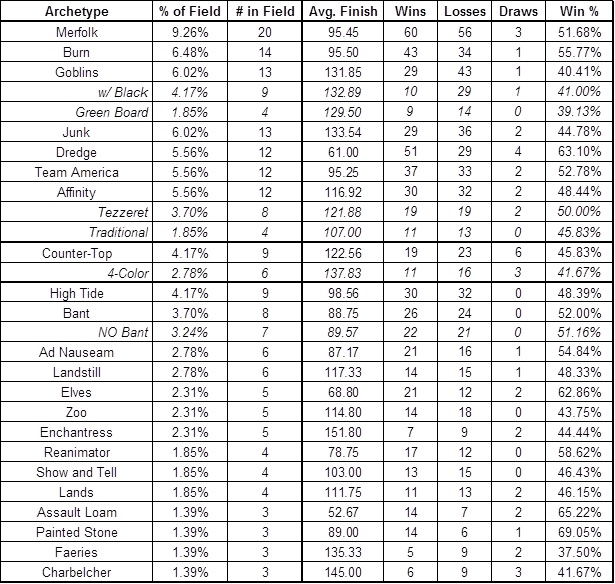
Merfolk filled the water once again in Los Angeles, but the story of the tournament became combo domination. Patrick Sullivan managed a Top 8 appearance with Lightning Bolt once again, this time in
Legacy, but he wasn’t happy to be facing a field of Dredge, Breakfast, Tendrils, and Painted Stone when he got there. While Jersey boy Patrick Sullivan
may have claimed the Top 8 slot, Burn as an archetype was incredibly popular thanks to a contingent of Arizona mages. They made a pact to bring the heat for Los
Angeles, and virtually everyone from the area showed up with Mountains.
Other than combo decks and the burners, only Bant, Merfolk, and Team America walked away from the tournament with satisfying performances. Note the
common element of strong disruption and nonlinear game plans between these decks, which are all about presenting a clock while pushing you around with
their spells. All three archetypes are highly adaptable and decision-intensive, rewarding skillful play and offering a lot of space to gain an edge. If
you’re looking to learn a Legacy deck, one of these options seems like a wise choice. Odds are that it will always be reasonable, and most of your
games will be competitive, at the least.
Painted Stone claimed the crown this weekend, after idling near the bottom of the charts for months.
Atlanta Legacy Open
Metagame Breakdown
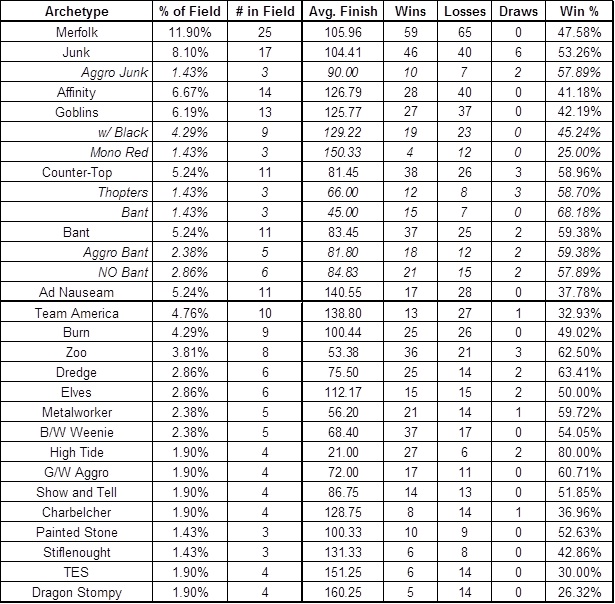
The Atlanta Legacy Open looked like a real coming-out party for the best decks in the format, splitting between the combo decks and the decks that can
beat them—plus Zoo? Dredge, Bant, and High Tide all proved themselves to be durable and resilient as the winds of Legacy once again changed direction.
Counter-Top’s success in the format isn’t unusual following Los Angeles. It’s a popular deck for talented players, which means that its percentages
will often inflate as its pilots outplay their bad matchups while maintaining margins elsewhere, especially against combo. I don’t mean to imply that a
deck like Counter-Top is any more skill-intensive or dynamic than a deck like Burn, but players in Legacy often pilot the decks they know and
like—Counter-Top in particular possesses a number of dedicated fans, and the deck is a strong choice against this field.
Bant jumped onto Tier 1 for the first time after coming close for weeks. Both Todd Anderson and Caleb Durward took down Top 8 slots, and you can read
their reports here and here, respectively. Bant is poised to become a major player as GP
Providence approaches, so I’d add it to your gauntlets now if you haven’t already. The only question is, “Natural Order or no?” Caleb finds the card inconsistent and unnecessary, but I saw Todd
summon his fair share of Legendary Hydras over the course of the day—what’s your call?
Zoo’s win percentage, highlighted by Pat Cox Top 8 finish, is
impressive considering the heavy combo element in the format…but as we all know, that combo element triumphed.
If not for Ben Wienburg stumbles, including a mirror match, we might have seen three High Tide lists in the Top 8. With 50% of the pilots making the
elimination rounds and a win percentage bordering on laughable, High Tide has won two Open Series and cemented itself as one of Legacy’s decks to beat.
Of course, High Tide is a very interesting enemy. Cunning Wish offers a resiliency to most of the hate—while you waste a turn playing whatever card you
boarded in or holding mana open for Pyroblast, that just buys them the time they need to sculpt an unbeatable hand and smash you. Duress effects are
strong, but a timely Meditate will often put them right back in the game while your weak clock offers little. What’s more, running highly dedicated
hate cards is a big gamble because Candelabra of Tawnos is actually so expensive that not everyone who wants to play High Tide can.
Ben Bleiweiss has theorized that there aren’t many more than 250 playsets available, and that poses a very interesting situation. Do you metagame
against a deck that can’t possibly become popular enough to dominate the field, or do you try and dodge all players named Hatfield while hoping
everyone else with High Tide punts their matches away? It’s a very different kind of metagame dilemma. I don’t have an answer yet, but as the Open
Series moves along and Providence nears, I imagine we’ll see one soon.
March Legacy Metagame Breakdown
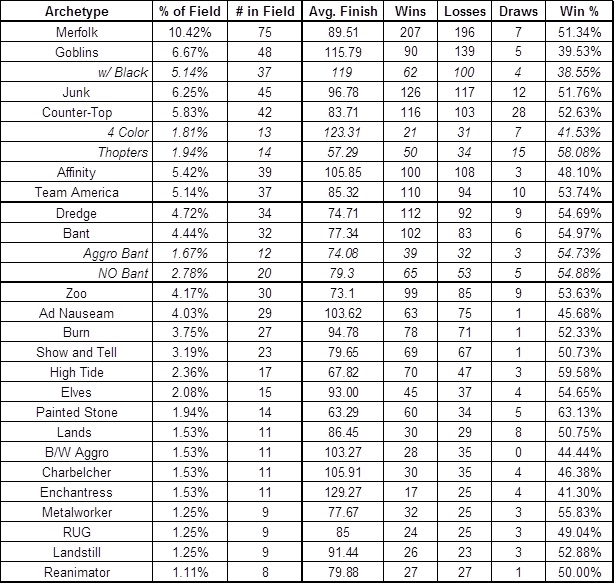
Not much that we don’t already know. Merfolk, Junk, Counter-Top, and Team America are very popular, with slightly favorable win percentages. Your bad
matchups are tough, but all of these decks offer significant play and have been successful in spite of being very known quantities. Another important
point is that players who really know their decks will be able to gain an increased edge. Let’s say that Merfolk’s actual win percentage against the
field was 51.34% (it’s not—the figures above are merely performance, not facts). In the hands of Alex Bertoncini versus another Merfolk player, you
would probably give him a significant edge against the same field because he knows the deck and the matchups so well that his mistakes are minimal, and
he can force more errors from the opposition. I can’t stress how important practicing your deck and studying your matchups is in Legacy.
Growing dangers are Dredge, Bant, and Zoo, with honorable mentions to Painted Stone and High Tide. It’s difficult to properly respect all of the combo
decks in the format, but Merfolk, Junk, and Bant appear best-equipped to do so while maintaining their margins against the rest of the upper tiers
consistently. Team America and Counter-Top are also viable, but more difficult to build for the format. Just look at the diversity in those decklists
over the past month—so much depends on personal preference and the matchups you’re dealt by DCI Reporter.
If you’re preparing for Grand Prix Providence, then that’s where I’d start. To help you out, I’ve analyzed the matchup percentages of Tier 1 below.
These figures will give you a strong head start, but remember that Legacy is a big format and most decks are incredibly adaptable. If you want to flip
a matchup in your favor, odds are you’ll be able to—the only variable is how much it will cost you elsewhere.
Merfolk — 10.42% of Field — Won 51.34% of Matches
Best finish: Alex Bertoncini, 1st place — Memphis Legacy Open
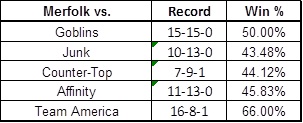
Merfolk is a strong and stable choice with few horrible matchups and a couple very strong ones. Its power against Team America and its ability to
compete with Bant are the two most attractive aspects of the deck in my mind. Over the past month, Merfolk has split its matchup against Goblins while
posting a losing record to Counterbalance. Both occurrences are very odd, but I’d chalk it up to sample sizes and pilot errors. I like Merfolk in this
environment, and wouldn’t fault anyone who wants to sleeve it up for the Grand Prix. Build a sweet sideboard, though—you’ll need it!
Goblins — 6.67% of Field — Won 39.53% of Matches
Best Finish: N/A
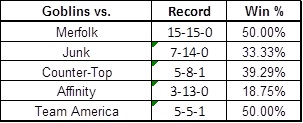
TL;DR: Don’t play Goblins.
I don’t have a list because the deck didn’t make the Top 16 in four weekends despite being the second most popular deck overall. It’s a rough time to
fight in a straight line, and all Goblins can do is turn guys sideways with increasing levels of efficacy as the game continues. It’s beating nothing
on Tier 1 and losing to almost every up-and-comer. Unless you’re a stone master or you’ve got some sweet technology, I’d steer clear of these little
guys for the time being. Goblins wasn’t just bad this month—it was awful every weekend, and I don’t see a reason for that to change with combo decks
picking up steam and Junk’s popularity growing.
Junk — 6.25% of Field — Won 51.76% of Matches
Best Finish: Sang Jung, 7th place — Dallas/Fort Worth Legacy Open
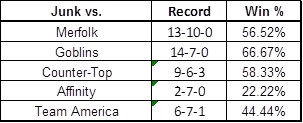
Another deck I think is fine in this format, there are a lot of directions to go with Junk. Pernicious Deed needs to find a home for those Affinity
matchups, as that card should swing them from dismal to downright awesome in a hurry. Beyond that, packing enough disruption to consistently defeat
combination decks like High Tide is a top priority, although the matchup is serviceable already. Remember, we were one catch away from crowning Eli
Kassis champion of the Edison Legacy Open. Junk’s made its fair share of Top 8s over the past few weeks, and it should continue to put up strong
performances amidst a field of decks doing more unfair things—just like its Rock ancestors.
Counter-Top — 5.83% of Field — Won 52.63% of Matches
Best Finish: David McDarby, 14th place — Atlanta Legacy Open
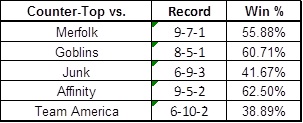
Counter-Top is too difficult a deck for me to comment on at length, to be honest. The deck is very powerful, but the direction that Legacy is taking
seems bad for it. When the format was all about cards that cost one and two mana, fighting off Aether Vials and locking up the game sounded like
child’s play, or at least like it was easy. Now people are casting Knight of the Reliquary, Green Sun’s Zenith, artifact creatures, and all manner of
scary things. Another factor to consider is how taxing it can be to play for a large number of rounds. Your games will go long, risking draws, and that
will wear on your ability to stay focused and rested for the entirety of the tournament. I’ve seen my fair share of Counter-Top pilots crumble in the
Top 8 as exhaustion creeps into their decisions.
Perhaps moreso than any control deck in history, Counter-Top is a sniper rifle. It’ll put a hole through whatever you hit, but you have to know how and
where to aim it. That’s no easy feat in an open Legacy metagame.
Affinity — 5.42% of Field — Won 48.10% of Matches
Best finish: Blake McCracken, 1st place — Dallas/Fort Worth Legacy Open
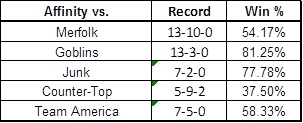
Fight! I’m not a fan of decks that are as one-dimensional as Affinity, but that’s not to say I don’t appreciate them. Affinity is the best at what it
does, and what it does is play a bunch of free dudes and try to beat you to death before you can do anything about it. Its strength against Merfolk and
Team America is pretty impressive, although as I said above, don’t write-off the Junk matchup as done. Considering how well Affinity has performed over
the last few events, players should be prepared to see more and more hate. I saw some Katakis in Atlanta, and you shouldn’t be too surprised to spot
more and more of them as the weeks wear on. Affinity’s clock can compete with combo, and its sideboard can pack a bit of disruption—tread softly.
Team America — 5.14% of Field — Won 53.74% of Matches
Best Finish: Chris VanMeter, 4th place — Memphis Legacy Open
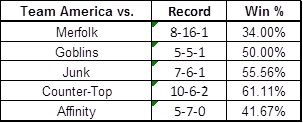
Team America started off strong in Memphis, but its power has waned. The deck is still good, and it combines a lot of different disruption into a very
tight little package. I imagine something like Gerry’s Dallas list might become more popular, given how strong Dark
Confidant seems in a format well-stocked with combo decks and with aggro on the run. Team America is a deck in transition, and its evolution before
Providence could hold some surprises for the metagame. If it finds a way to flip around that Merfolk matchup, I wouldn’t be at all surprised to see
this deck cruising straight to the top of the next Legacy Open Series. At a least, it remains an important boogeyman in every gauntlet.
That’s all for now, guys. The elephant in the room won’t be answered until we’ve had another couple tournaments, but at a minimum it has become clear
that Time Spiral’s unbanning has definitely changed the Legacy landscape. The top decks have remained in constant flux as player preferences and the
previous weekend’s results make it harder and harder to choose the right weapon, but hopefully this article has pointed you in the right direction. If
not, then ask your local Hatfield!
I’ll be in Boston for our next Open Series weekend. If you’re playing a sweet brew there, look me up—if you’re watching the coverage, you can tweet@SCGLive to let us know what you’d like to see. I’ve just started my own Twitter as well. @SecludedGlenn will offer my inane ramblings, sick brags, and
interesting TMI tidbits in preview form. Follow me if that sounds interesting!
–Glenn Jones
Coverage Content Manager
